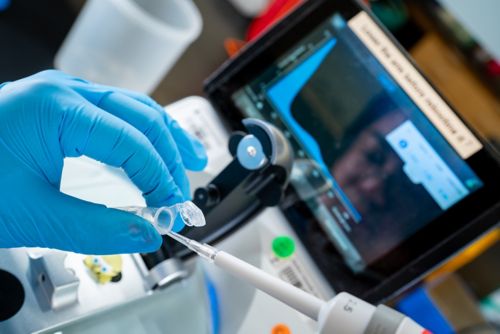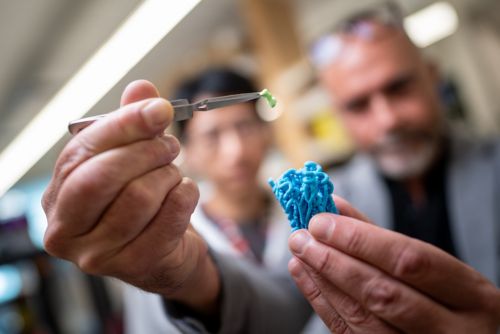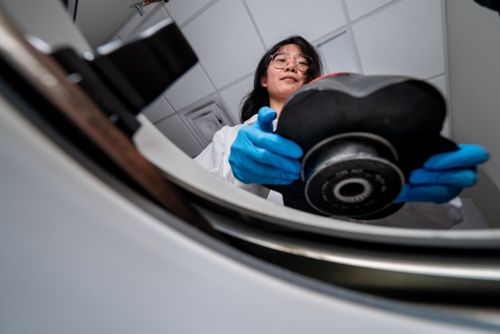St. Jude Family of Websites
Explore our cutting edge research, world-class patient care, career opportunities and more.
St. Jude Children's Research Hospital Home

- Fundraising
St. Jude Family of Websites
Explore our cutting edge research, world-class patient care, career opportunities and more.
St. Jude Children's Research Hospital Home

- Fundraising
Georgios Skiniotis Lab
Understanding the molecular mechanisms underlying intracellular communication via transmembrane receptor signaling.
About the Skiniotis lab

Cell surface receptors are essential components of intracellular communication. These membrane-bound proteins transmit extracellular signals to the cell interior, responding to a variety of extracellular cues including light, small molecules and ions, peptides, lipids, and proteins. G protein-coupled receptors (GPCRs) are a large, diverse group of cell surface receptors essential for human physiology and, given their distinct signaling roles, make attractive targets for therapeutic interventions. Our lab is interested in elucidating the structural and mechanistic aspects of signal recognition and propagation by cell surface receptors, namely GPCRs and their interacting proteins.
Our research summary
GPCR receptor signaling
G protein-coupled receptors (GPCRs) are a structurally conserved group of membrane proteins crucial for signal transduction in eukaryotes. Over 800 GPCRs have been identified in humans, each displaying specificity to a unique signal. Recognition of a cue by the extracellular side of a GPCR promotes conformational changes across the receptor to the intracellular side, inciting interactions with nearby G proteins. The activation of one G protein can have a cascade effect, modulating the production of hundreds of second messenger molecules that will spread the signal to the cell interior. As GPCRs are involved in controlling numerous crucial physiological processes, these receptors are attractive drug targets currently accounting for more than a third of approved therapeutic drugs.
We are interested in deciphering the mechanisms of signal transduction through detailing interactions between GPCRs and ligands, G protein subtypes, arrestins, and other effector complexes. Of particular interest are family C GPCRs, an exotic receptor group that includes crucial regulators of neurotransmission and systemic calcium levels. For example, we are keen on understanding how the calcium-sensing receptor (CaSR), a family C GPCR and master regulator of calcium homeostasis, instigates signaling. Our recent work has elucidated how CaSR undergoes conformational transitions in calcium binding that can drive the activation of distinct subtypes of G proteins.

We are also interested in structure-based ligand discovery initiatives aimed at characterizing the binding properties of small molecules and their effects on receptor structure and dynamics. This work lays the foundation for the development of next-generation ligands that may serve as potential efficacious therapeutics and highly specific tool compounds used to uncover biological mechanisms.
Our innovative approach
Our investigations employ primarily cryo-electron microscopy (cryo-EM) and cryo-electron tomography (cryo-ET) to ascertain the 3D architecture and the dynamic behavior of macromolecular complexes. By coupling these powerful methodologies with molecular dynamics simulations, functional assays and other biophysical approaches, our team has made transformative discoveries that shape our understanding of GPCR signaling mechanisms.
Many of the high-resolution structures generated by our lab have come from in vitro experiments, but we are expanding our methodology to include cryo-ET to visualize GPCR signaling networks in situ, gathering a more physiologically accurate representation of these dynamic interactions. We are developing and optimizing cryo-ET workflows to view the spatial arrangements of GPCRs and other receptors in their native environment. Our exploration on this front and refinement of current structure-based approaches allows us to peek into complex biological questions in a unique manner.

Publications
Contact us
Georgios Skiniotis, PhD
Member, St. Jude Faculty
Department of Structural Biology
MS 311, M6434
St. Jude Children's Research Hospital

Memphis, TN, 38105-3678 USA GET DIRECTIONS
